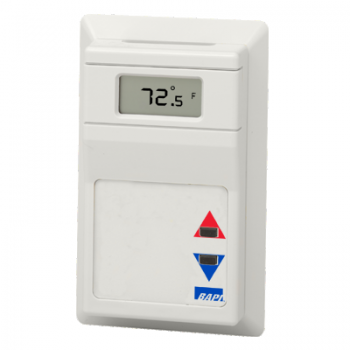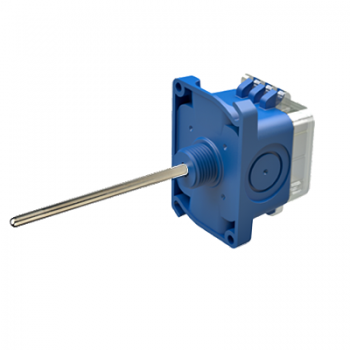
With the many types of temperature sensors available today, finding the perfect temperature sensor for your needs can get confusing. This is especially true for technicians that are new to the trade! Have no fear, Industrial Stores is here to answer all of the questions you should be considering when purchasing a temperature sensor.
What Is A Temperature Sensor?
Before we can dive into the specifics of temperature sensors, we need to make sure you know what they are first! A temperature sensor is an electric device that technicians use to test temperatures of certain environments. This can include; air temperature, liquid temperature, or even solid matter. The temperature readings are recorded in order to help monitor temperature changes.
Technicians must ensure that their sensor is giving accurate readings, which is why finding a responsive and reliable sensor is essential for the job!
Search for accurate and responsive sensors like the BAPI Temperature Sensor below.


How A Temperature Sensor Works
There are many different types of temperature sensors, however, in this blog we will be focusing on resistance temperature detectors (RTDs) because they are generally more accurate and have greater stability. RTDs utilize a resistive element, with an external monitoring device a data logger is used to provide a current to the RTD. By measuring the drop in voltage in the resistor, the RTDs resistance can be converted into an extremely accurate temperature rating.
Watch this outstanding video by The Engineering Mindset to learn more about the different types of temperature sensors and how they work.
14 Questions Technicians Ask About BAPI Temperature Sensors
It is important for technicians to research the temperature accuracy of a sensor before they purchase it. For example, Industrial Stores sells BAPI sensors, which are known for their reliability. Below is a list of 14 important questions technicians need to know about BAPI RTDs.
1) Are BAPIs Handheld Temperature Sensors Really That Accurate?
The proof is in the pudding! Check out these Accuracy Specifications BAPI has provided for their RTDs down below.
BAPI states that the tolerances of their basic values for platinum temperature sensors are specified in DIN EN 60751.
The following applies:
Class 2B: ?t=±2(0.3°C + 0.005 |T|) T = Temperature in °C of your specific operating temperature
*Class B: ?t=±(0.3°C + 0.005 |T|) T = Temperature in °C of your specific operating temperature
*Class A: ?t=±(0.15°C + 0.002 |T|) T = Temperature in °C of your specific operating temperature
Class 1/3 DIN: ?t=±1/3 (0.3°C + 0.005 |T|) T = Temperature in °C of your specific operating temperature
Class 1/10 DIN: ?t=±1/10 (0.3°C + 0.005 |T|) T = Temperature in °C of your specific operating temperature
|T| = The Absolute Value of T Example: |-100| = 100 and |100| = 100
*BAPI stocks Class A, Class B 100? and 1K? Platinum (Pt) RTDs
Swipe left to see more
2) What Is The Average Length Of A BAPI Probe?
The length of BAPI temperature probe and sensors differs. BAPIs temperature sensor probes can be anywhere from 4 to 100 feet, in 1-foot increments. BAPI's temperature sensor probes' standard lengths are typically 8, 12 & 24 feet. After that, pricing will be based on 10-foot lengths. For example, a 31-foot unit is priced the same as a 40-foot unit!
3) How Many Elements Are In A BAPI Thermistor Averaging Sensor?
Below 24 feet, there are 4 elements in a BAPI Thermistor Averaging Sensor. At 24 feet and longer, there are 9 elements.

4) Where The Heck Are The Sensors Located In A BAPI Thermistor Averaging Sensor?
BAPI sensors are spaced evenly across the length of the averaging sensor, with the first sensor always at the tip. For example, in an 8-foot unit, the first sensor would be at the tip, and the other 3 would be equally divided along the 8-foot length, meaning there would be a sensor at 8 feet (tip), 6 feet, 4 feet, and 2 feet. You can use this process to figure out the sensor locations on any length of BAPI's temperature sensor probes.
5) What Sheath Casing Is Used In A BAPI Thermistor Averaging Sensor?
BAPI claims that aluminum construction is the standard, but copper is also available for high humidity areas or other areas where galvanic reaction with the aluminum could present issues!

6) Can A Thermobuffer Have Dual Sensors??!
All of the BAPI thermobuffers can have two sensors installed except the ones that have a one-inch length cylinder buffer (-M304-1 option). This buffer chamber is too short for two sensors.
7) Which BAPI Sensors Will Fit Into BAPI's Pre-Pot Cup
Thermistors: 2.2K, 3K, 10K-2, 10K-3, 10K-3[11K], 30K, 47K and 50K.
RTDs: 100, 100[3W], 1K, 1K[3W], 1K[375] and 1K[NI].
8) What BAPI Sensors Require A Heat Shrink Shell?
Thermistors: 1.8K, 3.25K, 3.3K, 10K-4, 10K-5, 20K &100K
Semiconductors: 592, 592-10K, 334 & 335
RTDs: 2K silicone & 2KT1
9) Which BAPI Thermistors Are Available As High Precision With An Accuracy of ±0.1ºC?
Have a question about temperature sensor accuracy? The list below is the only thermistors that are available with the high accuracy [XP] option:
Thermistors: 3K[XP]*, 10K-2[XP], 10K-3[XP], 20K[XP]*, 100K[XP]*
*Minimum quantities and long lead times may apply.
10) Which RTDs Are Available As High Precision [A] With An Accuracy Of ±0.15ºC?
The list below is the only RTDs that are available with the high accuracy [A] option:
100[A] = 100 ? Platinum @ 0 °C, .385 ?/°C temp. coeff.
1K[A] = 1K ? Platinum @ 0 °C, 3.75 ?/°C temp. coeff.
1K[375][A] = 1K ? Platinum @ 0 °C, 3.75 ?/°C temp. coeff.
1K[NI][A] = 1K ? Nickel @ 21°C, 5 ?/°C temp. coeff.
11) What Are The Temperature Display Limits Of The BAPI Room Sensors?
Looking for a temperature sensor with display and have a question about its limitations? The measurement and display limits are the same as the internal Temp/RH combination sensor and are the same for temp-only thermistor units at -40 to 85ºC or -40 to 185ºF.
12) What Is The Wire Run Limit Of The BAPI External 10K-2 Thermistor (EXT-SEN option)?
Testing has shown ~30 feet. The input of the sensor does not have any transient protection circuitry, so the wire should be shielded. It is also recommended by BAPI that the drain wire be terminated to the common of the sensor. The sensor end of the shield should be taped back and insulated from any ground contact.
13) Does BAPI Have Documentation That Shows The Calibration Procedure or Certification For Its Platinum RTD Sensors?
Platinum RTDs cannot be calibrated in the field but they can be verified. Calibration is done during the manufacturing of the sensor element itself and once made cannot be changed.
Platinum RTDs come in two general varieties:
1) Class B (0.12% @ 0°C)
2) Class A (0.06% @ 0°C), which is more accurate.
BAPI offers RTDs that are NIST traceable and show the exact accuracy of the sensor as referenced to the National Institute of Standards and Technology (NIST). This will tell you how far off the sensor is from perfect accuracy and then the contractor can put an offset in the BAS controller to compensate for any error in the sensor. Platinum RTDs are very linear and repeatable, so an offset at one temperature point will track throughout the entire temperature span of the sensor.
BAPI customers can specify the temperature point (or multiple points) for the NIST certification. BAPI recommends that you select an NIST certificate point that is a center scale for the application in which the sensor is used, such as 72ºF for a room sensor. This is the best method to ensure an accurate reading.
Platinum RTDs can be verified in the field but this is never as accurate as a factory NIST certification. Any field testing must be done very carefully with the reference probe as close as possible to the sensor Device Under Test (DUT). The reference probe will need to remain next to the DUT for a few minutes until the two readings are stable. The reference probe and meter must also be very accurate, typically meaning that it is NIST traceable. Since this is an air temperature verification, your hands/body (~95ºF) and your breath (~85ºF) must be kept away from the DUT and reference probe tip during the test. A fair comparison test is when you add all the equipment inaccuracies together, such as the test probe, sensor DUT, and the BAS controlling equipment accuracy, to get a final acceptable ± accuracy tolerance. If the reading from the test probe and DUT is within this accuracy tolerance, then the sensor is acceptable.

14) Are BAPI Thermistors Susceptible To EMI/RFI?
BAPI claims that their thermistors by themselves are not susceptible to EMI/RFI interference unless they are placed in a very high energy field that would increase self-heating. This means that putting them in the direct field output of a radar dish would be a bad idea. The wire connecting the thermistor could have so much voltage induced on the leads that it may heat up the thermistor. This would have to be a sustained 2+ volts (2V/10K?=0.2mW). Other than that, the thermistor temperature will remain accurate in the presence of small amounts of EFI/RFI. However, most thermistors have a fairly high resistance (10K?) and the circuitry they are connected to (BAS controllers) may be influenced by EMI/RFI interference. The problem is the connected circuitry, not the thermistor. That’s why most installation sheets require twisted and shielded wire to keep the induced voltage to a minimum.
Let’s Get You The Temperature Sensor You Need Today
Here at Industrial Stores, our expert staff are well-equipped to help you find the best temperature sensor for your needs. We will also source the right unit for you, get you reduced prices, and deliver the unit to you quickly and safely.
Shop for temperature sensors at Industrial Stores today to discover the best prices.
CHECK LATEST PRICES
What Others Said About Industrial Stores
Our happy customers love our friendly service, fast shipping, and comprehensive inventory.
Some of the compliments and positive reviews that come up most include:
-
Service beyond the obvious, always ensuring customer satisfaction
-
Fast and convenient shipping with order tracking, giving you peace of mind
-
Cost savings by finding you more affordable alternatives
"Thank you so much for your hard work and concern, really appreciated."
— Luis S. Valverde, Thermo Air Inc., Hollywood, Florida
"I couldn't be happier to have saved hundreds of dollars."
— Ruben Marquez, Madison, WI 53711
"I have the part, it was here early AM - THANKS SO MUCH."
— Teresa Browder, Oak Farms Dairy, Houston, Texas







